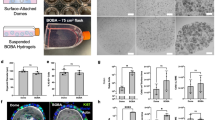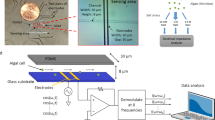Abstract
This protocol describes how to reconstruct and culture the freshwater rainbow trout gill epithelium on flat permeable membrane supports within cell culture inserts. The protocol describes gill cell isolation, cultured gill epithelium formation, maintenance, monitoring and preparation for use in experimental procedures. To produce a heterogeneous gill epithelium, as seen in vivo, seeding of isolated gill cells twice over a 2-d period is required. As a consequence, this is termed the double-seeded insert technique. Approximately 5–12 d after cell isolation and seeding, preparations develop electrically tight gill epithelia that can withstand freshwater on the apical cell surface. The system can be used to study freshwater gill physiology, and it is a humane alternative for toxicity testing, bioaccumulation studies and environmental water quality monitoring.
This is a preview of subscription content, access via your institution
Access options
Subscribe to this journal
Receive 12 print issues and online access
$259.00 per year
only $21.58 per issue
Buy this article
- Purchase on Springer Link
- Instant access to full article PDF
Prices may be subject to local taxes which are calculated during checkout





Similar content being viewed by others
References
Evans, D.H., Piermarini, P.M. & Choe, K.P The multifunctional fish gill: dominant site of gas exchange, osmoregulation, acid-base regulation, and excretion of nitrogenous waste. Physiol. Rev. 85, 97–177 (2005).
Wood, C.M. Toxic responses of the gill. in: Target Organ Toxicity in Marine and Freshwater Teleosts, Vol. 1 (eds. Schlenk, D.W. & Benson, W.H.) 1–89 (Taylor & Francis, 2001).
Mckim, J.M. & Erickson, R.J. Environmental impacts on the physiological mechanisms controlling xenobiotic transfer across fish gills. Physiol. Zool. 64, 39–67 (1991).
Bury, N.R., Walker, P.A. & Glover, C.N. Nutritive metal uptake in teleost fish. J. Exp. Biol. 206, 11–23 (2002).
Scholz, S. et al. A European perspective on alternatives to animal testing for environmental hazard identification and risk assessment. Regul. Toxicol. Pharmacol. 67, 506–530 (2013).
Fletcher, M., Kelly, S.P., Pärt, P., O'Donnell, M.J. & Wood, C.M Transport properties of cultured branchial epithelia from freshwater rainbow trout: a novel preparation with mitochondria-rich cells. J. Exp. Biol. 203, 1523–1537 (2000).
Kolosov, D., Chasiotis, H. & Kelly, S.P. Tight junction protein gene expression patterns and changes in transcript abundance during development of model fish gill epithelia. J. Exp. Biol. 217, 1667–1681 (2014).
Chasiotis, H., Wood, C.M. & Kelly, S.P. Cortisol reduces paracellular permeability and increases occludin abundance in cultured trout gill epithelia. Mol. Cell. Endocrinol. 323, 232–238 (2010).
Kolosov, D. & Kelly, S.P. A role for tricellulin in the regulation of gill epithelium permeability. Am. J. Physiol. 304, R1139–R1148 (2013).
Walker, P.A., Bury, N.R. & Hogstrand, C. Influence of culture conditions on metal-induced responses in a cultured rainbow trout gill epithelium. Environ. Sci. Technol. 41, 6505–6513 (2007).
Zhou, B., Kelly, S.P., Ianowski, J.P. & Wood, C.M. Effects of cortisol and prolactin on Na+ and Cl– transport in cultured branchial epithelia from FW rainbow trout. Am. J. Physiol. 285, R1305–R1316 (2003).
Kelly, S.P. & Wood, C.M. Cortisol stimulates calcium transport across cultured gill epithelia from freshwater rainbow trout. In Vitro Cell. Dev. Biol. Anim. 44, 96–104 (2008).
Schnell, S. et al. Environmental monitoring of urban streams using a primary fish gill cell culture system (FIGCS). Ecotoxicol. Environ. Saf. 120, 279–285 (2015).
Carlsson, C. & Pärt, P. 7-Ethoxyresorufin O-deethylase induction in rainbow trout gill epithelium cultured on permeable supports: asymmetrical distribution of substrate metabolites. Aquat. Toxicol. 54, 29–38 (2001).
Hansen, H.J.M., Kelly, S.P., Grosell, M. & Wood, C.M. Studies on lipid metabolism in trout (Oncorhynchus mykiss) branchial cultures. J. Exp. Zool. 293, 683–692 (2002).
Kelly, S.P. & Wood, C.M. The cultured branchial epithelium of the rainbow trout as a model for diffusive fluxes of ammonia across the fish gill. J. Exp. Biol. 204, 4115–4124 (2001).
Zhou, B., Nichols, J., Playle, R.C. & Wood, C.M. An in vitro biotic ligand model (BLM) for silver binding to cultured gill epithelia of freshwater rainbow trout (Oncorhynchus mykiss). Toxicol. Appl. Pharmacol. 202, 25–37 (2005).
Stott, L.C., Schnell, S., Hogstrand, C., Owen, S.F. & Bury, N.R. A primary fish gill cell culture model to assess pharmaceutical uptake and efflux: evidence for passive and facilitated transport. Aquat. Toxicol. 159, 127–137 (2015).
Minghetti, M., Schnell, S., Chadwick, M.A., Hogstrand, C. & Bury, N.R. A primary Fish Gill Cell System (FIGCS) for environmental monitoring of river waters. Aquat. Toxicol. 154, 184–192 (2014).
Walker, P.A., Kille, P., Scott, A., Bury, N.R. & Hogstrand, C. An in vitro method to assess toxicity of waterborne metals to fish Toxicol. 30, 67–77 (2008).
Pärt, P., Norrgren, L., Bergström, B. & Sjöberg, P. Primary culture of epithelial cells from rainbow trout gills. J. Exp. Biol. 175, 219–232 (1993).
Wood, C.M. & Pärt, P. Cultured branchial epithelia from freshwater fish gills. J. Exp. Biol. 200, 1047–1059 (1997).
Kelly, S.P., Fletcher, M., Pärt, P. & Wood, C.M. Procedures for the preparation and culture of 'reconstructed' rainbow trout branchial epithelia. Methods Cell Sci. 22, 153–163 (2000).
Sandbichler, A.M., Egg, M., Schwerte, T. & Pelster, B. Claudin 28b and F-actin are involved in rainbow trout gill pavement cell tight junction remodelling under osmotic stress. J. Exp. Biol. 214, 1473–1487 (2011).
Sandbacka, M., Pärt, P. & Isomaa, B. Gill epithelial cells as tools for toxicity screening—comparison between primary cultures, cells in suspension and epithelia on filters. Aquat. Toxicol. 46, 23–32 (1999).
Kramer, N.I. et al. Development of a partition-controlled dosing system for cell assays. Chem. Res. Toxicol. 23, 1806–1814 (2010).
Bols, N.C. et al. Development of a cell-line from primary cultures of rainbow trout, Oncorhynchus mykiss (Walbaum), gill. J. Fish Dis. 6, 601–611 (1994).
Tanneberger, K. et al. Predicting fish acute toxicity using a fish gill cell line-based toxicity assay. Environ. Sci. Technol. 47, 1110–1119 (2013).
Stadnicka-Michalak, J., Schirmer, K. & Ashauer, R. Toxicology across scales: cell population growth in vitro predicts reduced fish growth. Sci. Adv. 1, e1500302 (2015).
Berthios, Y., Katzenellenbogen, J.A. & Katzenellenbogen, B.S. Phenol red in tissue culture media is a weak estrogen: implications concerning the study of estrogen-responsive cells in culture. Proc. Natl. Acad. Sci. USA 86, 2496–2500 (1986).
Wood, C.M., Eletti, B. & Pärt, P. New methods for the primary culture of gill epithelia from freshwater rainbow trout. Fish Physiol. Biochem. 26, 329–344 (2002).
Acknowledgements
This work was funded via a grant supporting S.S. from the National Centre for the Replacement, Refinement & Reduction of Animals in Research no. 26675, awarded to C.H. and N.R.B. L.C.S. was funded by a studentship from the Biotechnology and Biological Sciences Research Council (BBSRC) co-funded Case Award (BB/J500483/1) supported by the AstraZeneca Global Environment research program to N.R.B. and C.H. C.M.W.'s research is funded by a Natural Sciences and Engineering Research Council of Canada (NSERC) Discovery grant. S.P.K. is funded by an NSERC Discovery Grant. S.F.O. is an employee of AstraZeneca. AstraZeneca is a biopharmaceutical company specializing in the discovery, development, manufacturing and marketing of prescription medicines. Funding bodies had no role in the design of the study or decision to publish. The work aims to identify effective alternatives to reduce, refine and replace the use of live animals to meet environmental regulatory testing needs.
Author information
Authors and Affiliations
Contributions
S.S. and L.C.S. contributed equally to the manuscript and generated the data. S.S. developed the double-seeded inverted insert (DSII) technique. C.M.W., S.P.K. and P.P. developed the initial methodology. S.F.O., C.H. and N.R.B. supported the recent developments of the methods. C.H. and N.R.B. received funding for S.S. and L.C.S. that has enabled the development of the methods and expanded the use of the double-seeded insert (DSI) for the replacement of animals in toxicity testing and environmental monitoring. All authors contributed to the manuscript.
Corresponding authors
Ethics declarations
Competing interests
The authors declare no competing financial interests.
Integrated supplementary information
Supplementary Figure 1 Preliminary results of the characterisation of the double seeded inverted insert (DSII)
(a) Measurements of TER in developing double-seeded inverted insert (DSII) epithelia from 3 days. Freshwater (blue points) was added (after the dotted line) to the companion well compartment (the apical cell surface, whilst the insert contained L-15 medium) on day 7 resulting in an increase in TER still evident 24 hours later on day 8 (n = 5). Values are means ± SEM. (b) The primary cultured rainbow trout gill epithelium is functionally polarised. Once the DSII epithelium has developed its signature resistance and is electrically tight (by day 10 in this case), and replacing the cell culture medium on the basolateral side (the companion well compartment) to fresh water (indicated by dotted line) causes a rapid reduction in TER (n = 3). Values are means ± SEM. (c) A scanning electron micrograph of the apical cell surface of DSII showing the irregularly shaped epithelial cells with microridges (mr) and plasma membrane (pm). Bar = 20 μm. (d) and (e) Transmission electron micrographs of DSII showing the tight junctions between epithelial cells (arrows) and the apical (AP) cell surface with glycocalyx and the basolateral cell surface (BL)) and the mitochondria rich cell (mitochondria = mc), the nucleus (n) and the intercellular space (S). In (d) bar = 200 nm and in (e) bar = 500 nm. (f) and (g) Confocal microscope images of DSI epithelia where 24 hrs before cell fixing, epithelia were exposed to (f) symmetrical conditions with L-15 medium on both sides of the epithelium or (g) asymmetrical conditions with FW in the upper compartment and L-15 medium in the companion well and cell nuclei were stained with 5 μM Hoechst (blue) and tight junctions with zonula occludens 1 antibody (green). Bar = 50 μm.
Supplementary information
Supplementary Text and Figures
Supplementary Figure 1 and Supplementary Methods (PDF 1036 kb)
Rights and permissions
About this article
Cite this article
Schnell, S., Stott, L., Hogstrand, C. et al. Procedures for the reconstruction, primary culture and experimental use of rainbow trout gill epithelia. Nat Protoc 11, 490–498 (2016). https://doi.org/10.1038/nprot.2016.029
Published:
Issue Date:
DOI: https://doi.org/10.1038/nprot.2016.029
This article is cited by
-
Establishment of a striped catfish skin explant model for studying the skin response in Aeromonas hydrophila infections
Scientific Reports (2021)
-
Investigations to extend viability of a rainbow trout primary gill cell culture
Ecotoxicology (2017)
-
A fish intestinal epithelial barrier model established from the rainbow trout (Oncorhynchus mykiss) cell line, RTgutGC
Cell Biology and Toxicology (2017)
-
Application of the rainbow trout derived intestinal cell line (RTgutGC) for ecotoxicological studies: molecular and cellular responses following exposure to copper
Ecotoxicology (2017)
Comments
By submitting a comment you agree to abide by our Terms and Community Guidelines. If you find something abusive or that does not comply with our terms or guidelines please flag it as inappropriate.



